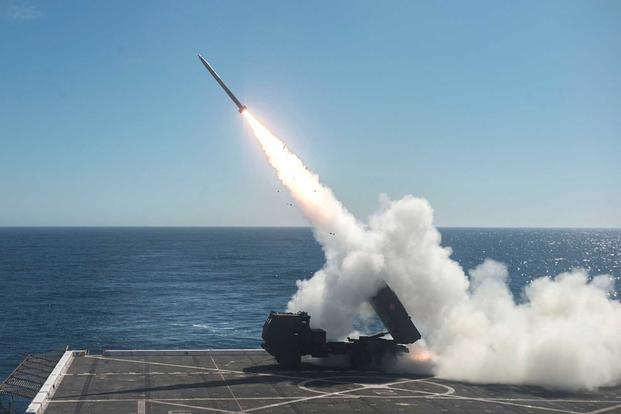Marines will test new ways to take out far-flung targets from Navy ships and ashore during the next phase of a years-long experiment meant to prep leathernecks for the future fight.
Long-range precision fires and command-and-control will be the focus of the next iteration of Sea Dragon 2025, Lt. Gen. David Berger, head of Marine Corps Combat Development Command, told Military.com on Thursday. The shift marks the third phase of a series of experiments -- first on infantry units and then on logistics -- that Marines have carried out in preparation for a high-tech fight against a near-peer enemy.
"We spent two years working on logistics and met last week to kind of wrap that up," Berger said. "Going forward will be a heavy dose of command-and-control and precision long-range fires."
Investment and training in long-range precision fires has been a focus in recent years. Last year, the Marine Corps more than doubled the amount of money it spent on its high-mobility artillery rocket systems, or HIMARS, from $60 million to $134 million.
Commandant Gen. Robert Neller also said in a 2016 operating concept document that Marines at the small-unit level would need long-range precision-fires capabilities as the maritime environment becomes more contested.
"The deep-water ports and high-throughput airfields we once relied upon are also increasingly vulnerable to attacks with long-range fires," Neller wrote. "These challenges will only grow as competitors pursue concepts for holding our forces at bay at greater distances and denying our ability to maneuver in both littoral and landward areas."
Berger said the hope is that Marines will practice taking out mock-targets from aboard amphibious assault ships as part of the Sea Dragon experiment. Ideally, he added, while speaking on Capitol Hill during the annual Navy Amphibious Warship Congressional Forum, the same system used at sea could also be easily moved to land.
"If you're going to control a region and you have an amphibious fleet," he told lawmakers, industry leaders and other guests at the forum, "then we're going to need long-range fires to take out maritime targets using sea-based or shore-based platforms."
The Marines have used HIMARS -- a C-5 transportable, wheeled, indirect fire, rocket/missile system -- on land and aboard an amphibious assault ship.
The Corps, Berger added, is also looking at ways to use unmanned aircraft or surface vehicles "to look for and kill things in the maritime domain."
"The pieces are there -- the air pieces are there and the surface pieces are there," he said. "The magic is combining it all together ... [but] it's all there and proven to be doable."
Unmanned technology such as robots and drones played a significant part in the experimentation infantry and logistics units carried out during previous phases of Sea Dragon 2025. The infantry Marines used drones to collect surveillance ahead of patrols. The logisticians used self-driving vehicles to get gear and medical supplies to the fight.
-- Gina Harkins can be reached at gina.harkins@military.com. Follow her on Twitter @ginaaharkins.














